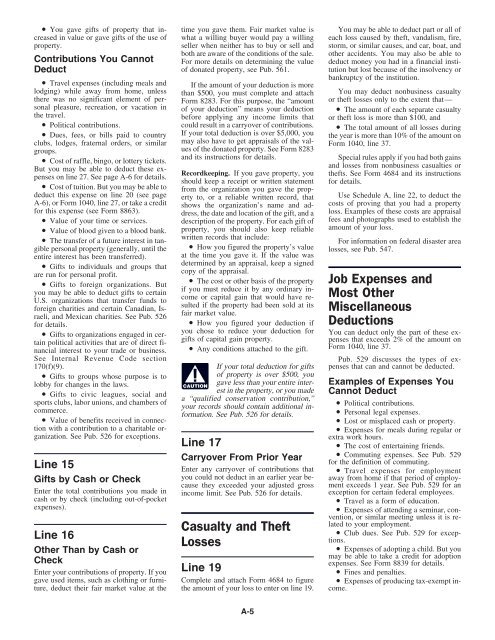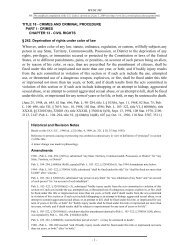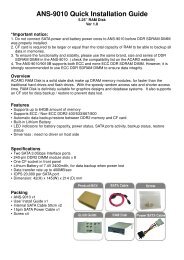2004 Instructions for Form 1040 (ALL) - Supreme Law Firm
2004 Instructions for Form 1040 (ALL) - Supreme Law Firm
2004 Instructions for Form 1040 (ALL) - Supreme Law Firm
Create successful ePaper yourself
Turn your PDF publications into a flip-book with our unique Google optimized e-Paper software.
• You gave gifts of property that in- time you gave them. Fair market value is You may be able to deduct part or all of<br />
creased in value or gave gifts of the use of what a willing buyer would pay a willing each loss caused by theft, vandalism, fire,<br />
property. seller when neither has to buy or sell and storm, or similar causes, and car, boat, and<br />
both are aware of the conditions of the sale. other accidents. You may also be able to<br />
Contributions You Cannot For more details on determining the value deduct money you had in a financial instiof<br />
donated property, see Pub. 561.<br />
tution but lost because of the insolvency Deduct<br />
or<br />
bankruptcy of the institution.<br />
• Travel expenses (including meals and If the amount of your deduction is more<br />
lodging) while away from home, unless than $500, you must complete and attach You may deduct nonbusiness casualty<br />
there was no significant element of per- <strong>Form</strong> 8283. For this purpose, the “amount or theft losses only to the extent that—<br />
sonal pleasure, recreation, or vacation in of your deduction” means your deduction • The amount of each separate casualty<br />
the travel. be<strong>for</strong>e applying any income limits that or theft loss is more than $100, and<br />
• Political contributions.<br />
could result in a carryover of contributions. • The total amount of all losses during<br />
• Dues, fees, or bills paid to country If your total deduction is over $5,000, you the year is more than 10% of the amount on<br />
clubs, lodges, fraternal orders, or similar may also have to get appraisals of the val-<br />
<strong>Form</strong> <strong>1040</strong>, line 37.<br />
groups.<br />
ues of the donated property. See <strong>Form</strong> 8283<br />
and its instructions <strong>for</strong> details.<br />
• Cost of raffle, bingo, or lottery tickets.<br />
Special rules apply if you had both gains<br />
But you may be able to deduct these exand<br />
losses from nonbusiness casualties or<br />
Recordkeeping.<br />
penses on line 27. See page A-6 <strong>for</strong> details.<br />
If you gave property, you thefts. See <strong>Form</strong> 4684 and its instructions<br />
should keep a receipt or written statement <strong>for</strong> details.<br />
• Cost of tuition. But you may be able to from the organization you gave the propdeduct<br />
this expense on line 20 (see page erty to, or a reliable written record, that Use Schedule A, line 22, to deduct the<br />
A-6), or <strong>Form</strong> <strong>1040</strong>, line 27, or take a credit shows the organization’s name and ad<strong>for</strong><br />
this expense (see <strong>Form</strong> 8863).<br />
dress, the date and location of the gift, and a loss. Examples of these costs are appraisal<br />
costs of proving that you had a property<br />
• Value of your time or services. description of the property. For each gift of fees and photographs used to establish the<br />
• Value of blood given to a blood bank. property, you should also keep reliable amount of your loss.<br />
• The transfer of a future interest in tanwritten<br />
records that include:<br />
For in<strong>for</strong>mation on federal disaster area<br />
gible personal property (generally, until the • How you figured the property’s value losses, see Pub. 547.<br />
entire interest has been transferred). at the time you gave it. If the value was<br />
• Gifts to individuals and groups that<br />
determined by an appraisal, keep a signed<br />
are run <strong>for</strong> personal profit.<br />
copy of the appraisal.<br />
• Gifts to <strong>for</strong>eign organizations. But • The cost or other basis of the property Job Expenses and<br />
you may be able to deduct gifts to certain<br />
if you must reduce it by any ordinary in-<br />
come or capital gain that would have re- Most Other<br />
U.S. organizations that transfer funds to<br />
<strong>for</strong>eign charities and certain Canadian, Isfair<br />
market value.<br />
sulted if the property had been sold at its<br />
Miscellaneous<br />
raeli, and Mexican charities. See Pub. 526<br />
<strong>for</strong> details.<br />
• How you figured your deduction if Deductions<br />
• Gifts to organizations engaged in cergifts<br />
of capital gain property.<br />
penses that exceeds 2% of the amount on<br />
you chose to reduce your deduction <strong>for</strong> You can deduct only the part of these extain<br />
political activities that are of direct fi-<br />
• Any conditions attached to the gift. <strong>Form</strong> <strong>1040</strong>, line 37.<br />
nancial interest to your trade or business.<br />
See Internal Revenue Code section<br />
Pub. 529 discusses the types of expenses<br />
that can and cannot be deducted.<br />
170(f)(9).<br />
If your total deduction <strong>for</strong> gifts<br />
• Gifts to groups whose purpose is to<br />
of property is over $500, you<br />
lobby <strong>for</strong> changes in the laws.<br />
gave less than your entire inter-<br />
Examples of Expenses You<br />
est in the property, or you made<br />
• Gifts to civic leagues, social and<br />
Cannot Deduct<br />
a “qualified conservation contribution,”<br />
sports clubs, labor unions, and chambers of<br />
your records should contain additional incommerce.<br />
• Political contributions.<br />
<strong>for</strong>mation. See Pub. 526 <strong>for</strong> details. • Personal legal expenses.<br />
• Value of benefits received in connec-<br />
• Lost or misplaced cash or property.<br />
tion with a contribution to a charitable or-<br />
• Expenses <strong>for</strong> meals during regular or<br />
ganization. See Pub. 526 <strong>for</strong> exceptions.<br />
extra work hours.<br />
Line 17<br />
• The cost of entertaining friends.<br />
Carryover From Prior Year • Commuting expenses. See Pub. 529<br />
<strong>for</strong> the definition of commuting.<br />
Line 15<br />
Enter any carryover of contributions that • Travel expenses <strong>for</strong> employment<br />
Gifts by Cash or Check<br />
you could not deduct in an earlier year be- away from home if that period of employcause<br />
they exceeded your adjusted gross ment exceeds 1 year. See Pub. 529 <strong>for</strong> an<br />
Enter the total contributions you made in income limit. See Pub. 526 <strong>for</strong> details. exception <strong>for</strong> certain federal employees.<br />
cash or by check (including out-of-pocket<br />
• Travel as a <strong>for</strong>m of education.<br />
expenses).<br />
• Expenses of attending a seminar, convention,<br />
or similar meeting unless it is related<br />
to your employment.<br />
Casualty and Theft<br />
Line 16<br />
• Club dues. See Pub. 529 <strong>for</strong> excep-<br />
Losses<br />
tions.<br />
Other Than by Cash or<br />
• Expenses of adopting a child. But you<br />
may be able to take a credit <strong>for</strong> adoption<br />
Check<br />
expenses. See <strong>Form</strong> 8839 <strong>for</strong> details.<br />
Enter your contributions of property. If you<br />
Line 19<br />
• Fines and penalties.<br />
gave used items, such as clothing or furni- Complete and attach <strong>Form</strong> 4684 to figure • Expenses of producing tax-exempt inture,<br />
deduct their fair market value at the the amount of your loss to enter on line 19. come.<br />
A-5













